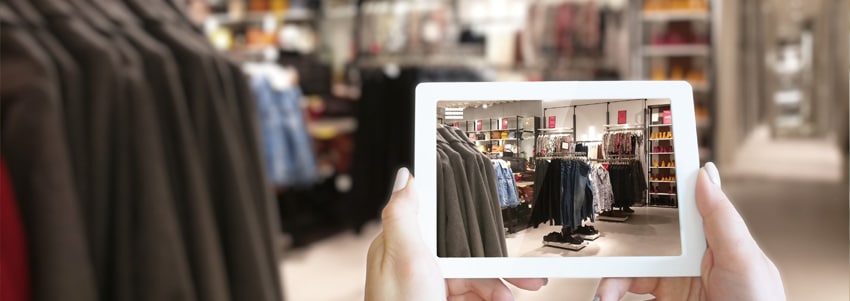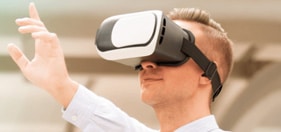How to Transform Your Business by Using Appropriate AR/VR Apps in the Best Possible Way
abr 28, 2022 | 42Gears Team
Augmented reality (AR) and virtual reality (VR) have been identified as key technologies that would support the Fourth Industrial Revolution. These technologies can be a game-changer for different organizations operating in different domains. Through the use of AR and VR technologies, businesses can provide an innovative way for their customers to experience their products and services.
According to a recent report released in 2020 by BusinessWire, the global VR market is projected to account for a revenue of $1,274.4 billion in 2030, rising from $37 billion in 2019, progressing at a compound annual growth rate (CAGR) of 42.9 % during the forecast period 2020-2030.
Since these technologies are being used by smartphone users, businesses should ensure that they launch mobile-friendly AR-VR applications. Businesses need to consider AR and VR as part of their overall strategy to bring improvements in key areas. Understanding these technologies and how they impact businesses are crucial to developing appropriate AR/VR strategies.
Let’s understand AR and VR in detail.
What are AR and VR?
AR can be defined as an enhanced form of the actual physical world, which is created by using digital graphics, sound, or diverse types of technology-generated sensory stimuli. Unlike VR, AR doesn’t separate the user from the physical or the real world. AR and its applications are practical for all types and sizes of businesses.
VR involves the deployment of computer technology to generate simulated 3D environments that may or may not be similar to the real world. VR takes users into an immersive 3D world where they can interact with the virtual elements. The gaming industry was an early adopter of VR; however, in recent years, it has found widespread use in multiple sectors including healthcare, automotive, education, marketing, manufacturing, and finance.
AR and VR help businesses in many ways. For example, AR gives customers the flexibility of viewing a particular product in their own environments, which contributes to faster deal closure. On the other hand, VR also helps businesses improve their sales and customer experiences. For example, if a customer wants to see a model of a car that is unavailable at the showroom, VR allows him/her to get a virtual 360-degree view of the model simply through the use of a VR headset.
How can AR/VR be used to revolutionize business processes?
The applications of AR/VR technologies have an enormous scope and businesses should tactically deploy AR/VR solutions to bring meaningful changes in critical areas.
Let’s see how AR/VR applications impact diverse businesses in diverse industries:
1. Transformation of Industrial Training

AR and VR can potentially transform industrial training and make sessions more interesting, consistent, and safe. Industrial undertakings are generally vulnerable to hazards and this makes on-site staff training difficult. AR and VR promote training in a safe and controlled environment, thereby making training more result-oriented. Employers can benefit from better-trained people, fewer accidents, reduced injury-related costs, higher levels of employee- safety, lower insurance costs, and less production downtime or fewer delays.
2. New and Innovative Customer Experience

Ensuring the delivery of a positive customer experience is very important for businesses to build customer loyalty and increase sales. AR and VR technologies have the power to generate innovative and amazing customer experiences. Some retailers, such as Gucci, have integrated AR features into their retail apps, which allows customers to digitally check out garments and other accessories by using cameras on their smartphones. This helps customers to make clear and well-thought-out decisions.
The NH Hotel Group is also offering innovative online 360-degree virtual tours of its hotel rooms using VR. This helps customers to get rooms based on their expectations. And this, in turn, increases customer satisfaction and loyalty.
3. Enhancement of the Retail Shopping Experience

These days, people prefer online shopping over shopping in brick-and-mortar stores due to the convenience and degree of engagement that online shopping is commonly associated with. By deploying AR and VR technologies, brick-and-mortar stores can deliver better experiences to their customers and stay ahead of their competitors including online retailers. Notably, Nike uses AR and VR in its physical stores. Customers can scan products such as a piece of clothing or a pair of shoes to view the information they need. They can also learn how Nike’s supply chain works by using VR technologies.
4. Promotion of Impulsive Buying
AR and VR are immersive technologies that also have the potential to induce impulsive buying. The deployment of these technologies can affect the shopping habits of people and help businesses increase their customer base (and revenues).
5. Remote Troubleshooting
AR/VR has simplified remote troubleshooting processes. Technicians can monitor problems remotely and troubleshoot them in real-time using their mobile devices. This saves a lot of time and effort while minimizing downtime.
Final Word
Brands have recognized the power of immersive technologies such as AR and VR. By using AR/VR experiences, businesses can benefit both on the marketing and operational fronts and make their processes more efficient, engaging, and sales-oriented.
However, before implementing AR/VR-based processes, businesses should develop a proper strategy after analyzing what would actually work for them. Additionally, to manage, monitor, and secure AR/VR devices, they need a Unified Endpoint Management (UEM) solution. A UEM solution is key to remote troubleshooting, thus increasing productivity and reducing downtime. 42Gears offers a robust and reliable UEM solution, which may help companies implement AR/VR strategies successfully.
Are you looking for a VR device
management solution?
Subscribe for our free newsletter








